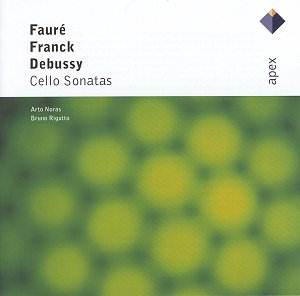Although renowned as an organist and pedagogue in his
Parisian days, the Belgian César Franck’s later years, from 1880,
produced his most memorable and popular compositions, such as the Symphonic
Variations (1885), the Symphony in D minor (1888), the String Quartet
(1889), and the Violin Sonata (1886). This last mentioned work was arranged
for cello, not by Franck, but by his publisher after his death because
the composer apparently intended to write a work for cello. Originally
written for the violinist Ysaÿe, it works fairly well for cello
though loses something of its sunny nature at the lower pitch. The other
two works on this attractive disc were conceived for the instrument,
the first of them by Fauré. He wrote two sonatas for the cello,
both of them late works, and this is the first written in 1917. Essentially
a Romantic work, it is nevertheless steeped in the classical approach
of his mentor Saint-Saëns rather than the impressionistic music
being produced at the time by Ravel and Debussy (he even outlived the
latter by six years). It’s not the harmonic language of the familiar
Requiem, but remains tuneful and highly expressive. Fauré became
deaf towards the end of his life and his music has a reflective inner
sadness, especially in the tender slow movement of this sonata, but
the passionate finale releases the tension at several glorious climaxes.
Debussy’s cello sonata was written in the middle of the First World
War (1915) at Pourville, after a year of creative sterility. It heralded
a final spurt before the cancer against which he was battling, killed
him three years later, and he decided to write six sonatas for various
instrumental combinations, of which only half saw the light of day,
this cello sonata, one for flute, viola and harp, and a violin sonata.
He initially gave the cello sonata the subtitle ‘Pierrot is angry at
the moon’, perhaps the whimsical second movement Sérénade
with its pizzicato, harmonics, and flexible sense of tempo is the explanation
(he later thought better and withdrew the description).
Arto Noras is a fine cellist with an evident affinity
for these works. He paints his tone colours with a broad brush, producing
not only technically assured playing but also a wide range of emotional
moods. The higher register of the instrument avoids any wiry sound despite
my reservations about the transcription of the Franck, it feels far
more natural in the Fauré sonata where the instrument soars up
the A string. Accompanist Bruno Rigutto provides full-bodied support,
always discreet, taking full advantage of the solos where he should.
The start of Debussy’s sonata is particularly impressive, boldly dramatic
before the Prélude’s slow section. The partnership of these two
musicians is a natural one based on a fine sense of striving for detail
and balance, and significantly more so in the Debussy than in the other
two works. The sound is bright, the recording quality excellent. This
is a worthy disc of the lesser known repertoire for cello, providing
a snapshot of French cello music as the Romantic era faded from view.
Christopher Fifield

![]() Arto Noras, cello
Arto Noras, cello ![]() TELDEC APEX 0927 40599
2 [56.26]
TELDEC APEX 0927 40599
2 [56.26]